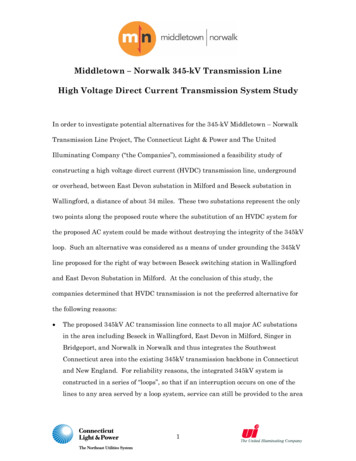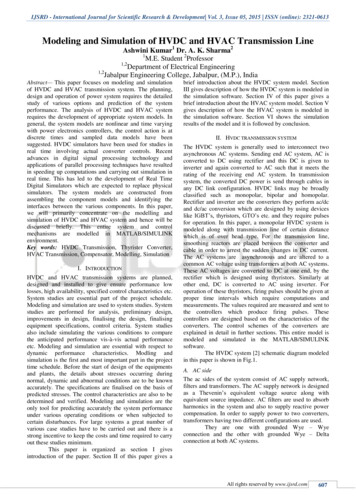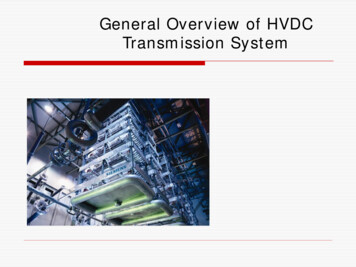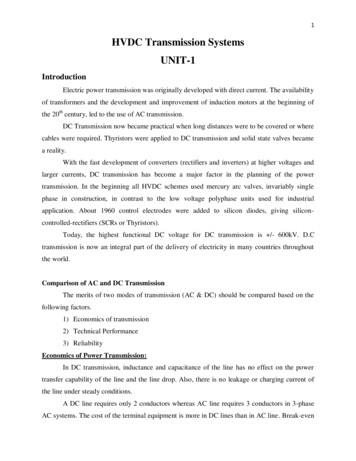
Transcription
Assessing HVDC Transmissionfor Impacts of Non‐DispatchableGenerationJune 2018Independent Statistics & Analysiswww.eia.govU.S. Department of EnergyWashington, DC 20585
June 2018Assessing HVDC Transmission for Impacts of Non‐DispatchableGenerationGiven the increase in renewable generation in recent years, it has become increasingly important tounderstand the manner in which operational challenges arising from intermittency may be mitigated withother technologies or operating procedures. One such technology is high-voltage direct current (HVDC)transmission lines. To help better inform the U.S. Energy Information Administration’s (EIA) long-termplanning models and projections, EIA commissioned a study from ICF Incorporated, LLC (ICF) to assess therole that HVDC transmission lines may play as additional renewable generation sources become integratedinto electrical grids.More specifically, ICF was asked to review the extent to which they believed HVDC lines may mitigatechallenges resulting from additional renewable generation, the advantages and disadvantages of using HVDClines to transmit the electricity generated from renewable sources, and the potential costs of constructingadditional HVDC lines in a formal analysis based on many sources of information.To provide some background, electricity generated by renewable resources can be categorized into twotypes—dispatchable and non-dispatchable generation. Dispatchable generation sources include conventionalhydroelectric, geothermal, and biomass. Non‐dispatchable (or intermittent or variable) generation sourceslike solar and wind, however, depend on the resource availability, such as when the sun is shining or the windis blowing. As a result, these technologies have limited capability to respond to generation dispatch signals.The increasing deployment and penetration of non-dispatchable renewable generation from resources likesolar and wind can lead to electrical system operational issues, which include under- or over-generationduring times of high or low electricity demand. Such conditions could potentially require additional gridservices to accommodate the associated fluctuations in generation delivered from these resources.Power transmission lines facilitate the bulk transfer of electricity from a generating station to a localdistribution network. The U.S. electric transmission network consists of around 700,000 circuit miles of lines.Most of these lines operate with alternating current, which is how power is typically generated and deliveredto the end-use customers.HVDC lines have typically been used to transfer large amounts of power over long distances. They are nowbeing proposed as a way to move electricity generated from wind in high-quality wind resource regions toother parts of the country. If properly configured, direct current transmission could also help mitigateoperational issues with wind and solar generation such as a mismatch in generation in relation to the needfor increased ancillary services associated with renewable generation. This can be accomplished byeffectively moving electricity generated from wind or solar resources from areas of high penetration to areaswith lower penetration.It should be noted that challenges associated with increased penetration of generation from wind and solarresources may also be mitigated using a variety of other technologies or practices, including smart gridtechnologies, energy storage, or other flexible generating technologies. However, the role that HVDC linesmay play in mitigating some of the potential challenges imposed by the growth in non-dispatchablerenewable generation on electric grids is an important consideration.U.S. Energy Information Administration Assessing HVDC Transmission for Impacts of Non‐Dispatchable Generation1
June 2018APPENDIXU.S. Energy Information Administration Assessing HVDC Transmission for Impacts of Non‐Dispatchable Generation2
Assessment of the Potential forHigh‐Voltage Direct CurrentTransmission to Mitigate Impacts ofNon‐Dispatchable GenerationTechnologiesFINAL REPORTMarch 2018Submitted to:United States Energy InformationAdministration (EIA)Washington, DCSubmitted by:ICF Incorporated, LLCFairfax, VA
Table of ContentsList of Figures . iiList of Tables . iiList of Abbreviations, Acronyms, and Initialisms . iii1. Summary of Findings . 12. Introduction and Background . 32.1. Objectives of Report . 32.1.1. Review of questions to be answered . 32.1.2. Discussion of approach . 42.1.3. Report structure. 42.2. Overview of HVDC Technology . 42.2.1. History of HVDC technology . 42.2.2. Modern HVDC lines deployment trends . 52.2.3. HVDC deployment in the United States. 62.2.4. Technical features of HVDC technology . 72.2.5. Advantages and disadvantages of HVDC transmission technology . 93. Analysis and Results . 133.1. Role of HVDC in Mitigating Non‐Dispatchable Generation Impacts . 133.1.1. Impact of large‐scale non‐dispatchable generation on system operation . 133.1.2. Potential HVDC solutions application . 153.2. Summary and Insights on Costs from HVDC Project Case Studies . 173.3. Cost Trends in HVDC Lines/Technologies in the United States . 233.3.1. Cost Estimates from specific case studies of HVDC projects (publicly available) . 233.3.1. Summary and insights on HVDC cost trends . 254. Conclusions . 285. References . 29Appendices . A‐1A.1. Case Studies of Potential Implementation of HVDC Solutions. A‐1A.1.1. TransWest Express Project in CAISO. A‐1A.1.2. MISO Conceptual HVDC Network Case Study. A‐6A.1.3. SPP’s Clean Line Project Case Study . A‐11A.2. Literature Survey on Applicability of HVDC for Renewable Integration . A‐18A.3. Literature Review on HVDC Project Costs . A‐27A.4. List of Existing and Proposed HVDC Projects in the United States. A‐30A.5. Glossary .A‐32i
List of FiguresFigure 1. Existing and planned HVDC lines and interties in North America . 7Figure 2. Schematic of an HVDC line . 9Figure 3. Comparison of HVDC to HVAC lines (losses and typical configuration) . 10Figure 4. Cost comparison curves for HVDC and AC lines (generic estimates). 12Figure 5. Generation capacity in the United States by fuel type (existing and planned) . 14Figure 6. Wind and solar generation capacity in the United States (existing and planned). 14Figure 7. Net generation trends in the United States (by fuel type) . 15Figure 8. Installed capacity trends for CAISO (existing and planned) . A‐1Figure 9. Recent net generation trends in California (GWh) . A‐2Figure 10. Proposed TransWest project in Western Interconnect . A‐4Figure 11. Installed capacity trends in MISO . A‐7Figure 12. Recent historical net generation trends in MISO (GWh) . A‐7Figure 13. Conceptual HVDC network assessed by MISO study . A‐9Figure 14. Square Butte HVDC line . A‐10Figure 15. Installed capacity trends in SPP . A‐12Figure 16. Recent historical net generation trends in SPP. A‐13Figure 17. Nodal and hub pricing trends in SPP “Wind Alley” region . A‐14Figure 18. Average net generation profile curve for SPP by the hour of the day (a typical spring week inMarch) . A‐15Figure 19. Overview of proposed clean line HVDC line . A‐17Figure 20. Unit cost estimates of HVDC technology . A‐29List of TablesTable 1. Penetration levels corresponding to historic market initiatives . 20Table 2. Maximum renewable penetration in select ISO/RTOs . 20Table 3. Changes in penetration levels for alternative mitigation solutions . 21Table 4. NREL JEDI project cost data for a hypothetical 500 kV, 100‐mile bi‐pole HVDC line . 25Table 5. Summary of recent literature on HVDC and its application in solving renewable intermittency. A‐23Table 6. Cost estimates of HVDC projects (based on literature review). A‐27Table 7. Transmission and infrastructure cost estimates (for a hypothetical HVDC line) . A‐29Table 8. Existing HVDC projects . A‐30Table 9. Proposed HVDC projects in the United States (selected) . A‐31ii
List of Abbreviations, Acronyms, and InitialismsACAlternating currentBLMBureau of Land ManagementBPABonneville Power AdministrationCAISOCalifornia Independent System OperatorCCCCapacitor‐commutated converterCFEComisión Federal de ElectricidadCIGRECouncil on Large Electric SystemsCREZCompetitive Renewable Energy ZoneDCDirect currentDIRDispatchable intermittent resourceDOEDepartment of EnergyEIEastern InterconnectEIMEnergy Imbalance MarketEIAEnergy Information AdministrationEPRIElectric Power Research InstituteERCOTElectricity Reliability Council of TexasETSAPEnergy Technology Systems Analysis ProgrammeFCAForward capacity auctionFERCFederal Energy Regulatory CommissionFOSGFriends of SupergridFRTFault ride throughGTOGate turn‐offHVACHigh‐voltage alternating currentHVDCHigh‐voltage direct currentHTPHudson Transmission ProjectIEEEInstitute of Electrical and Electronics EngineersIGBTInsulated‐gate bipolar transistorIGCTIntegrated gate‐commutated thyristorIOUInvestor‐owned utilityIRENAInternational Renewable Energy Agencyiii
List of Abbreviations, Acronyms, and InitialismsISO‐NEIndependent System Operator – New EnglandJEDIJobs and Economic Development ImpactLADWPLos Angeles Department of Water and PowerLCCLine‐commutated converterLCOELevelized cost of energyMIMass impregnatedMISOMidcontinent Independent System OperatorMMCModular multilevel converterMVPMulti‐value projectsNRELNational Renewable Energy LaboratoryNTTGNorthern Tier Transmission GroupPESPower & Energy SocietyPMUPhasor measurement unitQTRQuadrennial Technology ReviewRMSRoot‐mean squareROWRight‐of‐wayRPSRenewable portfolio standardSPPSouthwest Power PoolTSOTransmission system operatorTVATennessee Valley AuthorityTWETransWest ExpressUHVDCUltra‐high‐voltage direct currentVERVariable energy resourceVSCVoltage‐source converterWECCWestern Electricity Coordinating CouncilXLPECross‐linked polyethyleneiv
HVDC and Non‐Dispatchable Generation1. Summary of FindingsWorldwide, there has been a renewed resurgence and interest in developing high‐voltage direct current(HVDC) transmission projects for economic interregional transfer of electric power (Patel 2017). In theUnited States, several HVDC projects are in the planning pipeline to facilitate integration of renewableresources in remote host regions to distant load centers. This study examines the role of HVDC lines inmitigating the impacts of non‐dispatchable renewable generation technologies. Non‐dispatchabletechnologies (or intermittent or variable generation technologies), like solar and wind, operate based onresource availability, thereby creating dispatchability challenges for system operators. The reportaddresses a number of specific questions raised by the U.S. Energy Information Administration (EIA)designed to examine the circumstances under which HVDC lines play a role in integrating renewables, theextent to which HVDC lines can mitigate the impact of non‐dispatchable renewable generation, theconfigurations of HVDC suited for renewable integration, potential grid issues in using HVDC lines forrenewables integration, and the potential costs of constructing these lines based on experiences to date.This study is based on a three‐pronged approach. First, ICF reviewed several publicly available sources toassess the suitability of HVDC technology in addressing grid integration issues related to the developmentof renewable energy. Second, ICF compiled and summarized the recent trends in HVDC project costsbased on publicly available sources to address questions related to cost‐effectiveness of deploying HVDCsolutions for renewable integration. Third, ICF relied on three detailed case studies—TransWest Express(TWE) Project interconnecting Wyoming and California, Plains & Eastern’s Clean Line Project in SouthwestPower Pool (SPP) and the Tennessee Valley Authority (TVA) service territory, and MidcontinentIndependent System Operator’s (MISO’s) conceptual HVDC network—to address the questions outlinedin the project scope. The key findings from the study are summarized below.The negative impacts of non‐dispatchable renewable generation include generation curtailment,depressed or negative energy prices, system stability issues because of mismatch of generation anddemand, increased need for ancillary services, and inefficient unit commitment and dispatch. Increasedgrid interconnection through HVDC transmission would enable more flexibility in power transmission fromregions with excess renewable resources (host) to regions with high electricity demand (client). SinceHVDC is decoupled from the alternating current (AC) system, the transfer from the host to client regionscan be achieved with minimal impact on the underlying AC transmission system of the host region.Further, because HVDC has relatively low losses over long distances, the distance between the host andclient regions does not affect the ability to derive the renewable integration benefits.Without a detailed modeling of HVDC projects, it is difficult to ascertain if there would be any reliabilityimplications of using an AC network of the host region to interconnect renewable resources in the hostregion. The renewable penetration levels at which HVDC solutions are likely to be deployed (that is, in lieuof AC solutions) to mitigate non‐dispatchable generation impacts tend to vary across bulk power system.Factors such as the robustness of the underlying transmission network, the mix of generation resources,availability of flexible resources, and the nature of the ties to neighboring systems will all affect the levelat which HVDC solutions will be deployed. Nevertheless, the current consensus from a review of availableliterature is that HVDC lines make economic sense at higher penetration levels of renewables.1
HVDC and Non‐Dispatchable GenerationThe cost of an HVDC transmission system depends on many factors such as power capacity to betransmitted, type of transmission medium (submarine or land‐based), environmental considerations,access to easements rights‐of‐way (ROWs), and cost of converter stations and associated equipment. Alack of recent HVDC projects in the United States makes it difficult to ascertain typical project costs. Basedon a review of recent proposals and relevant regulatory filings, the cost of HVDC projects ranges between 1.17 million per mile and 8.62 million per mile (2017 ).2
HVDC and Non‐Dispatchable Generation2. Introduction and BackgroundEIA is interested in assessing the potential for HVDC transmission networks to mitigate the impacts ofnon‐dispatchable generation technologies. Non‐dispatchable technologies (or intermittent or variablegeneration technologies), like solar and wind, operate when the indigenous resources are available,thereby creating dispatchability challenges for system operators.Some of the key operational issues associated with variable or intermittent generation include lack ofsufficient generation resources during the times of high system demand, excess generation resourcesduring times of low system demand, and increased need for ancillary services (like spinning or non‐spinning reserves) to meet the ramping requirements associated with fluctuations in intermittentgeneration. One application of HVDC lines suggested in the literature is the use of these transmission linesto interconnect different regional power markets. These interconnections help to deliver power from apower surplus region (host region) to that of a power deficient region (client region). The HVDC terminalsfunction as a point‐source generation injection to balance variations in intermittent renewablesgeneration in a given regional network.The goal of the project is to assess the technical potential challenges in deploying HVDC interconnectionsto mitigate the impacts of variable generation, and evaluate recent cost trends associated with thesetypes of projects. As outlined in the project scope document, ICF addresses the following questions in thisreport: How and to what extent HVDC transmission may be used to mitigate non‐dispatchable generationimpacts?Are direct current (DC) tie lines between balancing authorities sufficient to transfer systemimpacts from host to client regions, or must the non‐dispatchable generator(s) be directlyconnected to the client region, bypassing any interaction with the host region?Are some system configurations and topologies of AC and DC interfaces more effective atmitigating some or all impacts from non‐dispatchable generation?At what penetration levels of non‐dispatchable generation would we expect these solutions to bedeployed?How does the penetration level change based on the type of non‐dispatchable technologydeployed, the share of conventional generation technologies, and/or other regionalcharacteristics?What other parameters influence and/or determine the deployment of HVDC?Are there limits to how well HVDC can mitigate intermittency impacts?What are estimates of the cost of deploying HVDC for these purposes at various levels of supply?The report addresses the following questions in relation to estimating the cost and rate of return oninvestment of deploying HVDC: What has been the historical cost per mile or cost per MW‐mile in developing HVDC transmissionfacilities in the United States?3
HVDC and Non‐Dispatchable Generation What are the cost components, specifically fixed (costs that are independent of line length) andvariable costs (costs that are a function of line length)?What factors influence these costs (such as regional labor costs, geography, population density,and so forth)?What cost‐related factors may constrain HVDC deployment?To address these questions, ICF reviewed several publicly available sources, mainly focusing on renewableenergy grid integration and HVDC line costs. Except for a few merchant HVDC projects, there have beenfew HVDC line projects in recent years in the United States. As a result, a lot of the current availableresearch on this topic originates from Europe, where many HVDC projects are being proposed and arecurrently being implemented for renewable integration. The sources discussed are mostly peer‐reviewedjournal articles, research reports, industry newsletters, or case studies published by industry vendors,research labs, and other reputed transmission industry stakeholders. The HVDC cost trends were alsoextracted from publicly available sources. The National Renewable Energy Laboratory (NREL) JEDI 2017report contains the most detailed cost breakdown of HVDC transmission including annual operation andmanagement (O&M) costs for hypothetical HVDC projects. ICF also relied on the Transmission ExpansionPlanning Tool used by the Western Electricity Coordinating Council (WECC) since 2014, which providescapital and other miscellaneous costs relating to HVDC transmission projects. The full list of resourcesexamined is included in the bibliography.The remainder of this section provides a brief historical background on HVDC technology. The third sectionexamines the main issues posed by EIA—examining the impacts of HVDC lines in mitigating the systemimpacts of variable energy generation from renewables. The report also examines three case studies—the TWE project interconnecting Wyoming and California, Plains & Eastern’s Clean Line Project in SPP andTVA, and MISO’s conceptual HVDC network—to highlight the challenges and issues related to HVDC andrenewable integration. This section includes a summary of insights from the three case studies in aquestion‐and‐answer format designed to address the questions raised in the project scope. The study alsoexamines the cost trends for recent HVDC projects to address the cost‐related questions in the projectscope. The Appendix includes five sections: a summary of recent reports and articles on utilizing HVDCtechnology to address renewable intermittency issues, detailed discussions of the shortlisted case studies,an inventory of existing and proposed HVDC projects in the United States, and a glossary of technicalterms used in the report.Power plants are often located near an energy source, such as a coal mine, to minimize fuel transportationcosts. These power plants often are located away from heavily populated load‐centers; therefore,transporting the electricity generated economically is important. This is accomplished by transmitting thegenerated power at a high voltage (stepping up at the power plant and stepping down at the substationusing a transformer at both ends). Early pioneers like Thomas Edison who first began to harness electricity4
HVDC and Non‐Dispatchable Generationfor useful purposes did this by placing generators right next to the equipment that used the electricity.These early generating stations delivered electricity over copper wires using DC, a method so inefficientthat the power plants had to be within a mile of the load they served.The first commercial power station was installed at Pearl Station in lower Manhattan, New York, in 1882(DOE 2014). In the late 1880s, George Westinghouse and others developed cost‐effective transformers tostep up and step down the voltage of AC electricity. With the development of transformers, AC powercould be sent over long distances using relatively smaller wires at a higher voltage. However, by the 1890sother inventors like Nikola Tesla further refined and commercialized the AC power distribution system.Cities across the world started constructing high‐voltage power transmission lines that used ACtechnology, thereby firmly establishing the prominence of AC technology for transmission purposes.Typically, transmission of electric power is accomplished at high voltages where the transmission lossesare minimized. For a given quantity of power, doubling the voltage will deliver the same amount of powerat half the current flow. Doubling the voltage reduces the power losses by a factor of four.1Most of the early attempts to transform the DC voltage to higher or lower levels relied on mechanicaldevices, which were not cost‐effective on a commercial scale. The early research on HVDC technology andpotential converter technologies was pioneered by Sweden’s ASEA (Long and Nilsson 2007). 2 Dr. UnoLamm of ASEA first patented low‐pressure mercury‐arc converters for HVDC applications in 1929. Therewere other technical and manufacturing issues before the first practical mercury‐arc valves could be built.Early demonstrations of HVDC technology was also tested and implemented in the Soviet Union (nowRussia) in 1951 between Moscow and the nearby city of Kashira (Long and Nilsson 2007). The firstcommercial HVDC link, developed by ASEA, was constructed in 1954 for carrying power between mainlandSweden and the island of Gotland. The line was rated at 100 (kilovolt) kV and had the capacity to deliver20 megawatt (MW) of power.In the 1970s, HVDC lines were constructed with solid‐state converter devices like thyristor valves. HVDCthat uses thyristor valves is also known as line‐commutated converter (LCC) HVDC (Long and Nilsson2007). In the mid‐1990s, voltage‐source converters (VSCs) were commercialized for HVDC applications. Inrecent years, power electronics devices like insulated‐gate bipolar transistors (IGBTs), gate turn‐off (GTO)thyristors, and integrated gate‐commutated thyristors (IGCTs), have made smaller HVDC systems moreeconomical (Rudervall, Charpentier and Sharma 2000). Currently, the longest HVDC line in the world isthe Rio Madeira link in Brazil, which connects hydropower plants in the Madeira River in the Amazon basinto major urban load centers like Sao Paulo and Rio de Janeiro in southeastern part of Brazil (ABB n.d. a).This HVDC link consists of two bipolar 600 kV DC transmission lines with a line length of 2400 kilometers(km) and a transmission capacity of 3150 MW on each pole. China currently leads in the construction ofHVDC transmission lines in the world today. China has also successfully implemented ultra‐high‐voltagedirect current (UHVDC) transmission lines in recent years (rated at 800 kV and above) (ABB 2016). China1Power P V*I. Doubling of voltage (V), reduces the current (I) by half.Power loss L I2*r (P/V)2*r. Doubling of voltage, reduces the losses (L) by a factor of four.2Allmänna Svenska Elektriska Aktiebolaget (ASEA) (General Swedish Electric Company) was a Sweden‐based engineeringcompany. In 1988, it merged with the Swiss company Brown, Boveri & Cie (BBC), which then became the ABB (ASEA BrownBoveri) Group. ASEA is now the holding company of ABB Group.5
HVDC and Non‐Dispatchable Generationis currently planning to build the Changji‐Guquan UHVDC link between Xinjiang regions in the northwestto Anhui province in the eastern region of China. The UHVDC line is expected to be rated at 1100 kVvoltage, 3000 km in length, and 12 gigawatt (GW) of transmission capacity. When completed, this projectis expected to set world records for HVDC lines in terms of voltage level, transmission capacity, and linelength.In the United States, the first commercial HVDC project was the 500 kV Pacific DC Intertie connectingBonneville Power Administration’s (BPA) service territory in the Pacific Northwest to Los AngelesDepartment of Water and Power (LADWP) service territory in California (Bonneville Power Administration2010). The
Assess ing HVDC . Transmission for Impacts of Non ‐Dispatchable Generation . June 2018 . Independent Statistics & Analysis . www.eia.gov U.S. Department of Energy










